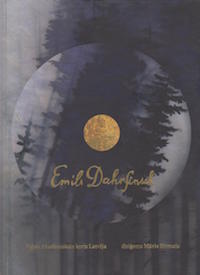Perhaps no other Latvian composer is as unconditionally beloved as the late National-Romantic Emīls Dārziņš. In his brief life, cut short at the age of 35, Dārziņš composed music that would resonate with every successive generation for more than a century – his music remains as vital today as it has ever been. His most famous composition – the singular symphonic work ‘Melanholiskais valsis’ (Melancholy Waltz) remains not only popular, but the defining work of Latvian symphonic music. His works for solo voice, such as ‘Teici to stundu, to brīdi’ and ‘Vēl tu rozes plūc’, remain recognizable and revered.
However, it is Dārziņš’ choir music that has become an immutable and irrefutable part of the Latvian cultural psyche. Tallying at a mere seventeen works (for mixed, men’s and women’s choir), each one is a treasure, and continue to inspire and leave a deep emotional impact.
2015 is the 140th anniversary of Dārziņš’ birth (and, sadly, the 105th anniversary of his death), and, in celebration of Dārziņš’ life and work, the State Choir Latvija, conducted by Māris Sirmais, undertook the daunting task of recording all 17 choir songs and has released them in the collection entitled simply Emīls Dārziņš, which is the first time all 17 have been collected on one album. As these songs are so very beloved and ingrained in Latvian music, expectations can be not only high, but perhaps even unrealistic that one choir can do all these songs justice. Fortunately, Latvija and Sirmais are more than up to the challenge, and succeed beyond all expectations.
Dārziņš was a fragile soul, and this fragility is woven through almost all of his songs, perhaps most notably in the women’s choir song “Nāru dziesma”, with lyrics by Jānis Jaunsudrabiņš. The performance, tenderly and delicately presented by the women of the choir, captures the essence of Dārziņš’ spirit – with just a few words and brief, quiet music which barely rises above a piano, it entrances the listener with its siren song of “Nāc, ak, nāc” (Come, oh come).
Perhaps the most tragic of Dārziņš’ works is the men’s choir song “Mūžam zili”, a Kārlis Skalbe poem set to music. The somber, subdued opening, with its lament of “Mūžam nav miera zem Latvijas bērziem, Mūžam raud kokle pār Latvijas kalniem” (There is never peace beneath Latvia’s birches, The kokle always cries over Latvia’s hills), displays the uncertainty of the Latvian nation, long suffering under centuries of foreign rule. As the song builds to its crescendo with the cry “Mūžam nerimst varoņu gars” (The spirit of the heroes never dies), it concludes with the near hopeless despair of the introduction – a moving and memorable performance by the men of the choir.
Dārziņš was innately able to capture in music the spirit of the words of his contemporary poets. For example, Aspazija’s poem “Mēness starus stīgo”, with its fantastic and vivid imagery, complemented with Dārziņš’ lyrical and delicate music, results in one of the richest choir music works in the Latvian repertoire. Beginning with its immediately recognizable male choir introduction, quietly sublime, the music, with Aspazija’s words, paints a resplendent picture, filled with the subtle nuances and grace of the choir.
The collection concludes with Dārziņš’ defiantly triumphant “Lauztās priedes” with lyrics by poet Rainis. The metaphorical broken pines, which, though broken, do not concede defeat – Rainis’ fiery conclusion – “Tu vari mūs šķelt, tu vari mūs lauzt, Mēs tāles sniegsim, kur saule aust!” (You can splinter us, you can break us, We will reach the heights where the sun dawns!) reflects not only the dawning of the Latvian nation at the beginning of the 20th century, but also the indomitable spirit of the Latvian people throughout the centuries. Dārziņš captures this spirit like no other in this work, one of the pillars of Latvian choir music. The State Choir Latvija brings forth the raw power and strength of this song, resulting in a truly soul-stirring rendition of this timeless classic.
The collection itself is presented in a beautiful hard-backed book, with extensive notes in Latvian on Dārziņš and his choir works by musicologist Arnolds Klotiņš, as well as detailed biographies of the choir and conductor Sirmais, and full texts for each work. In a charming touch, each book has a drawing of a pine tree that was glued in by hand.
These 17 pearls, though amounting to barely more than 40 minutes of music, continue to reverberate in the Latvian consciousness more than one hundred years later. Emīls Dārziņš is not just historically significant and precious, but also a stunning achievement by the State Choir Latvija and their mercurial conductor Māris Sirmais. After listening to this CD, the tragedy of Dārziņš’ brief time on this planet becomes even more pronounced and heartbreaking – if, during 35 years, the composer could compose such treasures, imagine what he could have done with another 35 years? We are blessed with these few works the composer was able to share with us, and blessed further that we have such a world class choir to present them to us in such an affecting and emotionally striking performance. Emīls Dārziņš is truly a testament not only to the composer’s genius, but also the unparalleled abilities of the choir Latvija and conductor Māris Sirmais.
For further information, please visit the State Choir Latvija website.
Emīls Dārziņš
State Choir Latvija
VAKL, 2015
Track listing:
- Nāru dziesma
- Sapņu tālumā
- Mirdzi, kā zvaigzne
- Pie tēvu zemes dārgās
- Minjona
- Nāc man līdz!
- Ja uz Betlēmi es ietu
- Ciānas bērni
- Es zinu
- Kapsētas klusums
- Šūpuļa dziesma
- Senatne
- Jūs kalni un jūs lejas
- Lai vētra krāc
- Mūžam zili
- Mēness starus stīgo
- Lauztās priedes
© 1995-2024 Latvians Online
Please contact us for editorial queries, or for permission to republish material. Disclaimer: The content of Web sites to which Latvians Online provides links does not necessarily reflect the opinion of Latvians Online, its staff or its sponsors.





